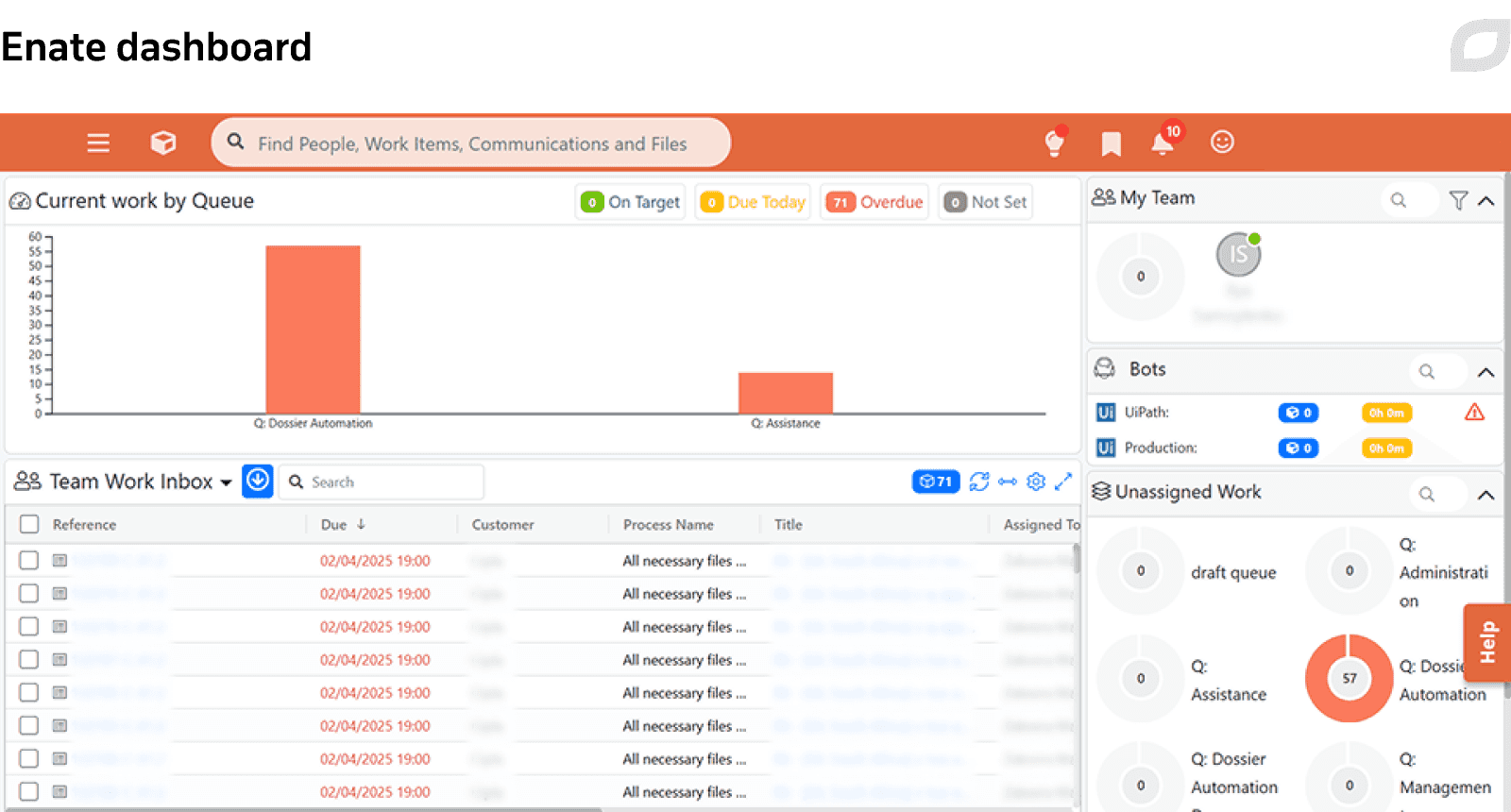
Pharma due diligence automation
We increased a pharmaceutical company’s operational efficiency by automating medicine dossier due diligence, reporting, and stakeholder notification with the help of RPA bots.
Challenge
The customer is a global pharmaceutical company with offices in EMEA and APAC and nearly 100 years of market presence that is renowned for producing world-class medicines. The company offers a diverse portfolio of 1000+ products spanning numerous therapeutic areas. In its ongoing quest for operational efficiency, the customer aimed to streamline several of the company's processes related to the regulatory registration or renewal of medicines. The most error-prone and time-consuming part of the new medicine registration process was the verification of medicine dossiers. All reviews of the dossier were conducted manually by pharmacists who spent 5+ days manually validating 300+ documents of each dossier against a strict structure and content regulations of health authorities. Therefore, the dossier due diligence was a repetitive process that took a lot of time and human effort. Additionally, when registering new medicines, the customer closely collaborated with health authorities and reported the information updates to stakeholders several times a day manually, which was time-consuming as well.
Therefore, the customer sought to automate the aforementioned labor-intensive processes. They decided to launch a project pursuing the following objectives:
- Increase operational efficiency by setting a transparent, rule-based flow of the medicine regulatory registrations and renewals process
- Reduce time for dossier due diligence from multiple days to hours by automating the process
- Reduce time spent by personnel on dossier due diligence by setting up a business notifications flow on medicine registration and automating decision-making
- Increase the accuracy of the documents submitted to regulatory authorities and reduce the number of re-works in the medicine regulatory registration process
To transform these objectives into tangible outcomes, the customer was searching for a reliable technology partner that could deliver and subsequently support a dossier due diligence automation solution and streamline the information updates to stakeholders.
They launched a tender requiring all participants to prepare and present a Proof of Concept (PoC) solution based on an excerpt of the dataset provided. Impressed with the PoC implemented by Itransition, as well as our extensive expertise in delivering enterprise-scale automation solutions across various industries and use cases, along with our AI and RPA expertise and Centers of Excellence, the customer decided to entrust the project to us.
Solution
Vision & strategy
After thoroughly analyzing the business context and initial requirements provided by the customer, Itransition recommended implementing a dossier due diligence automation solution. This solution would be built on a combination of two software platforms – UiPath and Enate – and tailored to meet the specific business needs of the customer. Enate would function as a business process management (BPM) solution, offering an intuitive interface for end-users to manage project and case workflows, oversee users and tasks, and access dashboards and reports. UiPath bots would be integrated with Enate via API to perform the actual dossier due diligence and automate additional tasks, such as importing the dossier into other corporate systems or exporting it from them. Both platforms are highly configurable, allowing for precise fine-tuning and customization of processes and automation tasks to meet the exact business needs of the customer and enabling easy addition of new workflows and bots to the system. This meant that, leveraging the combined strengths of Enate and UiPath, the proposed solution would offer extensive scalability and expansion capabilities.
Implementation & training
Itransition implemented a medicine registration flow in Enate, used as an interface for communications with the robot and orchestrating human and robot actions, and configured UiPath bots to validate dossier structure and content against predefined rules. Itransition also deployed a UiPath robot that collected all the information about the medicine from the product trackers to an email and sent it to the predefined groups of stakeholders.
We began our collaboration by developing a pilot version of the solution that covered the entire due diligence process. This pilot version performed a limited number of compliance checks for just one region while also managing the business notification process. This phase ensured that all parties involved were on the same page, preventing us from spending excessive time on clarifications or re-engineering later in the project. It also helped establish the project interaction framework and communication channels for trusted and effective collaboration from day one. During this pilot phase, our team specified and thoroughly documented the functional requirements and necessary dossier due diligence business rules.
We also built the platform’s foundation with future scalability in mind, configuring a set of bot- and machine learning-based checks and establishing integration with other corporate systems.

During the full-scale implementation phase, our team configured the necessary rules to assess the compliance of all modules within a dossier. This phase involved the incorporation of around 500 rules, more complex than those configured during the pilot phase. We also automated due diligence and notifications at other company branches, configuring processes in Enate to take into account specific rules of 50+ countries.
Having implemented the solution, we conducted a series of workshops for client stakeholders and showcased the system's functionality, demonstrated how to use the system, and explained how internal users would complete their tasks in view of the automated dossier due diligence process, while answering any questions that arose.
Functionality
Dossier due diligence
Compliance checks
UiPath bots performed comprehensive checks of all the required documents’ availability and their content in a dossier and could be used at any step of the dossier submission process. The customer's business rules for the required checks were transformed into algorithms for UiPath bots or machine learning models for more complex checks. Thanks to the platform configurations implemented by our team, these business rules could be easily modified and new checks for dossier subsets or country-specific rules could be added, thereby expanding the solution's automation capabilities as needed.
The actual tasks for the bot to run such automated checks were enabled with the help of Enate, with three main processes involving:
- Registration: initial registration of a medicine
- Variation: changes to a medicine's components
- Renewal: re-registration required after the initial registration expires
To extract and interpret data, we used the UiPath Document Understanding solution, which combines robotic process automation and artificial intelligence. Initially we planned to utilize the machine learning models included in Document Understanding for all checks, but their capabilities proved to be more suitable for standard, uniform documents. Since the documents in a dossier varied greatly, we decided to mainly leverage the RegEx (Regular Expressions) solution to search for matches based on defined patterns.
For cases requiring complex content analysis, such as checking molecular formulas’ structure, we developed a custom Python-based machine learning model trained to recognize complex formulas and indexes, which was triggered by the UiPath bot.
Task management
Enate bots covered the entire task management process. The platform enabled the creation of projects and project templates with pre-configured task sequences, the transfer of tasks between various users (both humans and bots), accurate tracking of task completion, and easy system notifications configuration.
While configuring the Enate solution, we occasionally resorted to customization using HTML, CSS, and Typescript (Angular) to create new parts of user interface and add custom content to meet specific project needs. This included the validation of the verification process, visualizing different elements in various cases, disabling certain fields, etc.
User enablement & security
User management for the solution was handled in Enate. The platform's functionality allowed various users to access a single dossier and its submission process steps. User authentication (such as password changes by users) and access rights were also managed via the Enate interface, which supported the role-based access model.
Reporting & analytics
Managers, scientists, and other stakeholders could view the dossier due diligence stages through the Enate interface. UiPath bots were configured to compile reports based on their due diligence checks, while overall reporting and analytics capabilities were provided via Enate dashboards.
By default, Enate's reporting did not include all necessary entities, so we added custom fields specifically for the customer’s reporting needs. The examples of tracked metrics included, for instance, the number of errors, their occurrence times, automation process duration, the number of successful verification completions, etc.
Business notifications automation
The notification process was quite complex and implied more than just forwarding an email. Instead, it required collecting information about the medicine registration from various sources, compiling it into a table, attaching necessary documents, and sending the notification with the accompanying text to stakeholders. This task typically took a human about 30 minutes to fulfill.
To streamline this process, we configured a UiPath bot to have access to all required data sources and automated the collection of all information and sending of the notification, reducing this process time to about 1-2 minutes. If any information was missing or incorrect, a human could intervene, make corrections to the message, and send the notification manually.
Results
Itransition helped an international pharmaceutical business automate the verification of medicine dossier compliance with the structure and content regulations of healthcare authorities. We also automated notification processes to quickly inform stakeholders about new medicine registrations or renewals.
- 1200+ of work hours saved monthly
- 40x faster dossier due diligence
- 95% robot accuracy
- 30x faster business notification flow
- 80% human effort reduction on information updates
- 100% notifications sent on time
- 300 notifications automated per month

Services
Agentic automation & RPA services
We deliver tailored process automation solutions for workflows of varying complexity, helping companies reduce manual effort across business operations.

Insights
RPA in healthcare: use cases, benefits & challenges
Learn how robotic process automation streamlines operations in healthcare and improves care delivery. Explore top RPA use cases, vendors, and adoption costs.

Insights
Top 10 RPA use cases by industry & real-life examples
Explore the top 10 use cases and successful implementation examples of robotic process automation for various industries.

Case study
Robotic process automation HR PoC
Learn how Itransition developed an RPA bot that automates addition of new candidates to the HRM, significantly increasing process efficiency and reliability.

Case study
Robotic process automation for a global logistics company
Learn how Itransition automated three labor-intensive logistics processes using robotic process automation, improving the company's operational efficiency.

Insights
Pharmacy automation solutions: top five scenarios, benefits & adoption guidelines
Discover how pharmacy automation software streamlines business processes and reduces manual effort, as well as how to integrate it into your workflows.

Case study
Atlassian suite optimization for a pharma solutions provider
Learn how Itransition helped a pharma provider fine-tune their Atlassian setup and migrate to Atlassian Cloud Enterprise, ensuring license costs optimization.

Case study
Pharmaceutical data analytics suite for a US multinational
Read about Itransition’s 10+ years long cooperation with a US-based multinational to create their flagship pharmaceutical data analytics products.